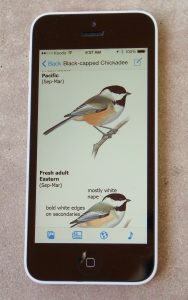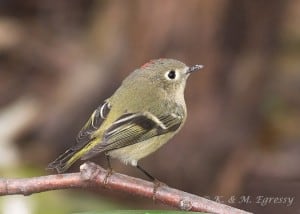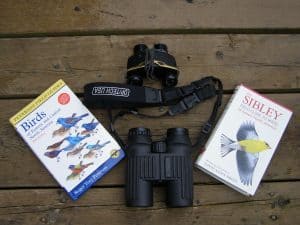By any measure, birding has never been more popular. Its allure lies in the satisfaction of using one’s knowledge of season, range, habitat, field marks, song and behavior to identify and appreciate the birds around us. Birding can also become a window on environmental issues. Many environmentalists started out as birdwatchers, perhaps because you quickly recognize just how vulnerable bird populations are to pressures like urban sprawl, habitat destruction and climate change.
Bird identification is about three things: Paying attention, being patient and knowing what to expect. Paying attention means looking and listening with complete concentration. Being patient can mean standing motionless in a forest for several minutes until the bird you just heard sing eventually calls again and lets you know where it is lurking. In fact, one can often see more birds by standing in one good spot than by always moving. Finally, knowing what to expect means having a good idea of what species should be present in a given time of year and habitat. Experienced birders have a 95 percent idea of what they will probably see in a given day and place. Birds are found at predictable times and locations.
So, just who is that little brown bird visiting your feeder? When you come across a bird you can’t immediately identify, try following these steps:
- Take note of the bird’s general shape. Many birds can be identified by shape alone, often at considerable distances. Is it stocky and short-tailed like a starling or slender and long-tailed like a grackle?
- Turn your attention to the bird’s size by comparing it to a common benchmark species. Ask yourself if it is closest in size to a hummingbird, sparrow, robin, crow, or goose.
- Examine the plumage and field marks. Take a careful look at the wings, underparts, rump, tail and head. If you find mnemonics (memory aids) useful, think WURTH. Start with the part of the bird you can see best, but try to look at its entire body before it flies away. Try to see if it has bars on the wing or if its chest, belly and sides have spots, stripes or a special coloration. Is there anything special about the tail or rump? Pay special attention to the head. Many small songbirds such as warblers and sparrows can be identified by characteristics of the head alone. Does the eye have a circle around it? Does the crown or throat have special markings such as stripes or a contrasting color? Take note of the size and shape of the bill.
- Watch what the bird is doing. Is it feeding on the ground, perched at the very top of a tree, moving headfirst down the trunk, standing motionless in shallow water or soaring high overhead? Is it alone or with others of the same species? Some common feeder birds, for example, almost always feed on the ground in small flocks (e.g., white-throated sparrow), while others are nearly always seen on feeders (e.g., black-capped chickadee). If the bird is flying, how would you describe its flight pattern? Some hawks, for example, soar in circles on motionless wings, while others have a “flap, flap and glide” style of flying.
- Consult your field guide or app. Don’t forget to look at the range maps, relative abundance of the species, whether it is migratory or resident, its preferred habitat and its typical behavior. The guide will also point out the most important field marks and how the bird compares to any similar species.
Keep in mind…
~ Bird identification is not an exact science and at times it is difficult to be completely certain of what species you have seen. Being “reasonably certain” is sometimes the best you can do.
~ When you are looking at an unidentified bird, remember that it could be a female or an immature. Although the male and female are quite similar in most species, there are birds — the red- winged blackbird, for example — where the differences are striking. Ducks, too, show a big difference between the sexes. When identifying eagles, hawks and gulls, remember that you might be looking at a juvenile or immature bird.
~ The bird in your binoculars may not be in its breeding plumage. In a small number of species (fortunately!), the plumage can vary considerably between spring and fall. These birds tend to be colorful in the breeding season but drabber in fall and winter. American goldfinches are an example of this challenging characteristic.
~ Many songbirds respond well to “pishing” and will come in quite close so that you can take a closer look.
Before you begin to pish, place yourself close to some trees or shrubs where the birds you wish to attract can land. Pucker your lips and make a loud, forceful “shhhh” sound, while tacking a “p” on at the beginning: “Pshhhh, Pshhhh, Pshhhh”. Make sure it sounds shrill and strident. You might want to try adding an inflection at the end, as in PshhhhEE. Do it in a sequence of three, repeating the sequence two or three times. At first, you’ll probably need to pish fairly loudly, but you can lower the volume once the birds get closer. Continue pishing for at least a couple of minutes after the first birds appear. This will give other species that may be present a chance to make their way towards you. Chickadees and nuthatches are especially receptive to the pishing sound, but other species like warblers and sparrows will usually approach as well.
~ The habitat in which you see the bird can also help with identification. Some species are almost never seen outside of their preferred habitat, except during migration.
~ Many birds are found along habitat edges such as the edge of a woodlot, a road or a wetland.
~ Learn common bird sounds. Identification by songs and calls will really boost your birding skills and provide a great deal of satisfaction. With practice, nearly all birds can be identified by song. Start by learning the songs of the common species you see and hear around your house. Listen to recordings of their songs — in the car, for example — and learn the associated mnemonic for the species you’re interested in. Chickadees, for example, sound like they are singing “Hi Cutie”. There are many bird identification apps that include songs and calls.
~ Purchase a pair of good binoculars. Many bird-waters find 8 x 40 or 8 x 42 the best choice. They provide good magnification but also offer a wide field of vision. Look for a pair with a roof prism design.
~ Choose a field guide with paintings of the birds rather than photographs, and a range map right beside the illustrations. My favourite is “The Sibley Field Guide to the Birds of Eastern North America” because of its convenient size and weight and the multiple plumages it shows of each bird. “The Sibley eGuide to Birds” is probably the best app available and includes recordings of all the songs and calls.
~ Check out seasonal abundance charts for your area. These show how the numbers of a given species change over the course of the year. With time, you will start to develop a mental checklist of what birds are most likely, given the time of year. The eBird website (ebird.org) provides these charts in the “Explore Data” section.
~ Keep track of your sightings — and share them with others — by using eBird. Subscribers also receive alerts of rare birds in your area as well as birds you have not yet seen during this year
Bird identification is one of many skills for connecting to nature. Next week, we’ll turn our attention to butterflies, dragonflies and moths. You will find more ways to develop a stronger connection to the natural world in my new “Big Book of Nature Activities: A Year-Round Guide to Outdoor Learning” which I co-wrote with Jacob Rodenburg, executive director of Camp Kawartha. The book will be available in early June.


